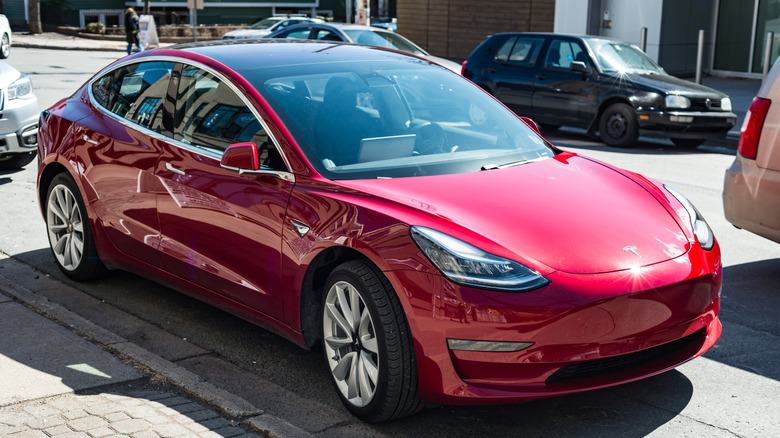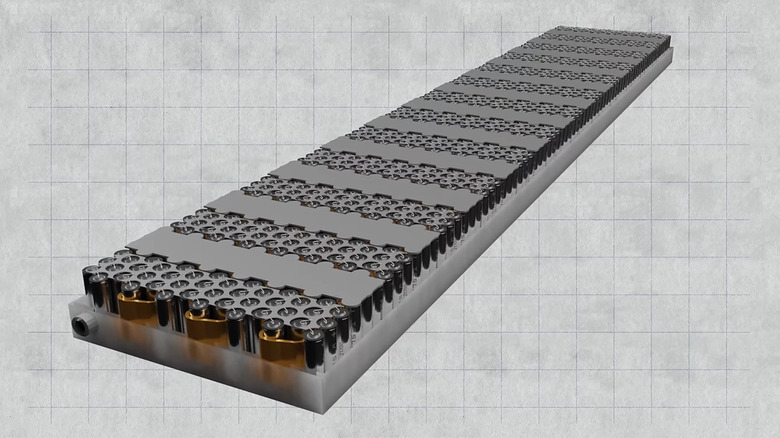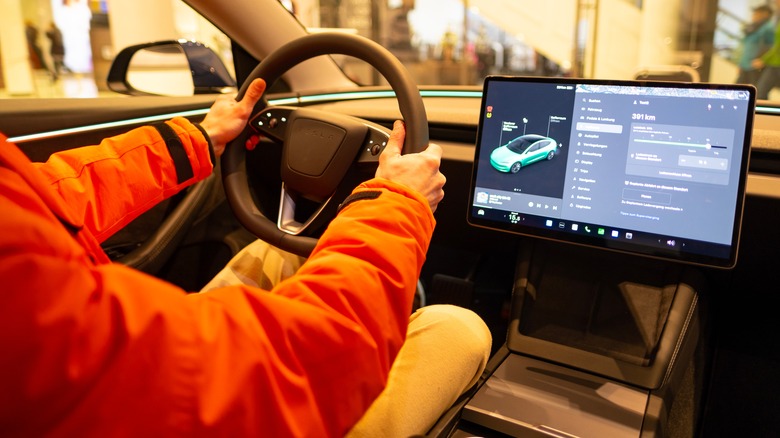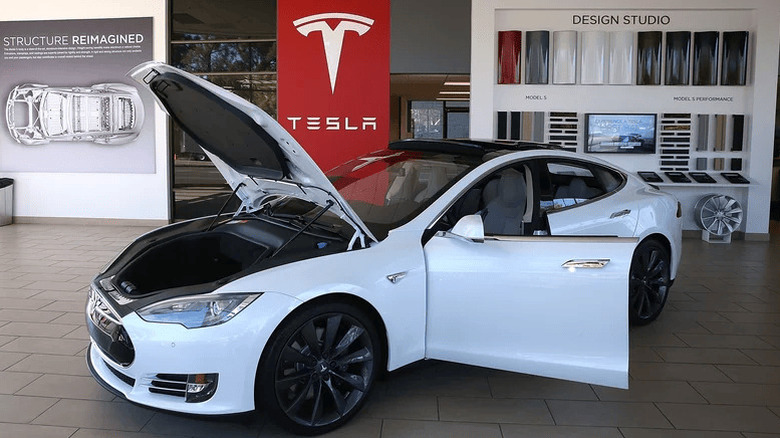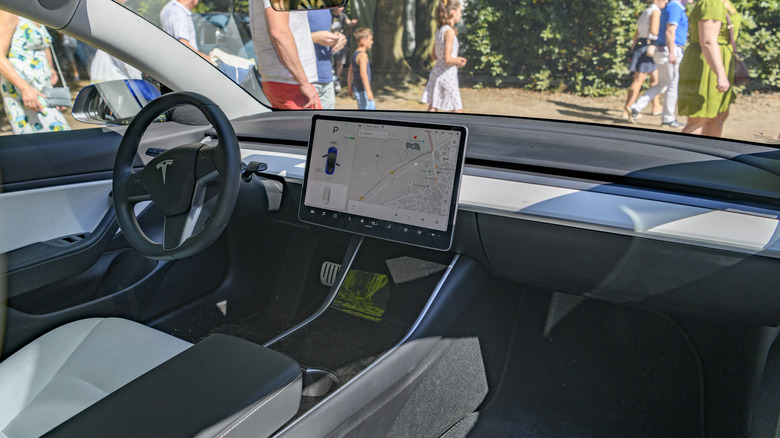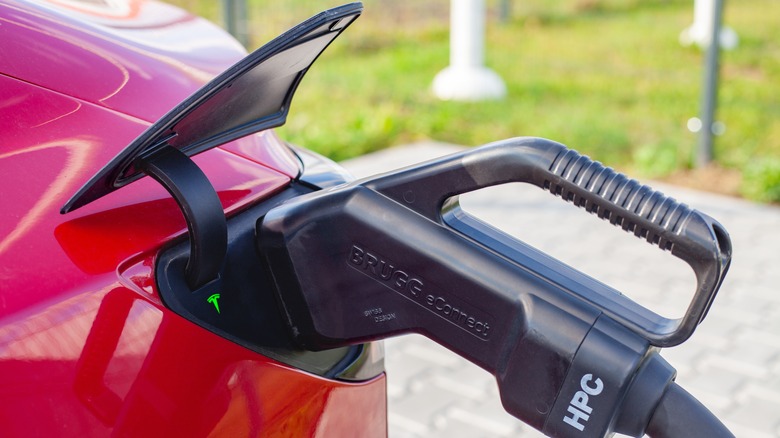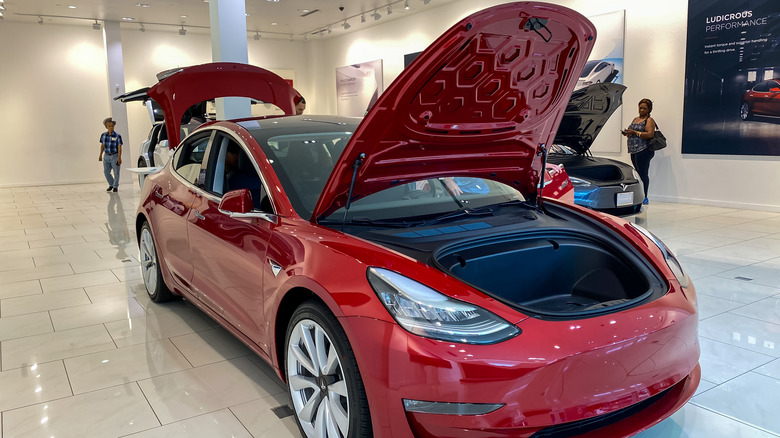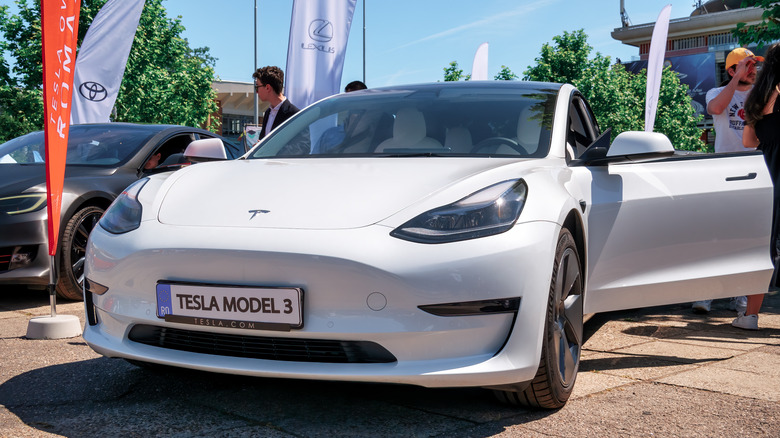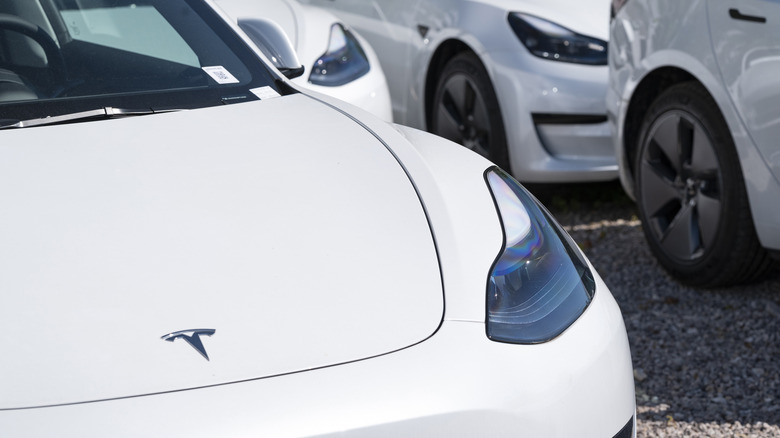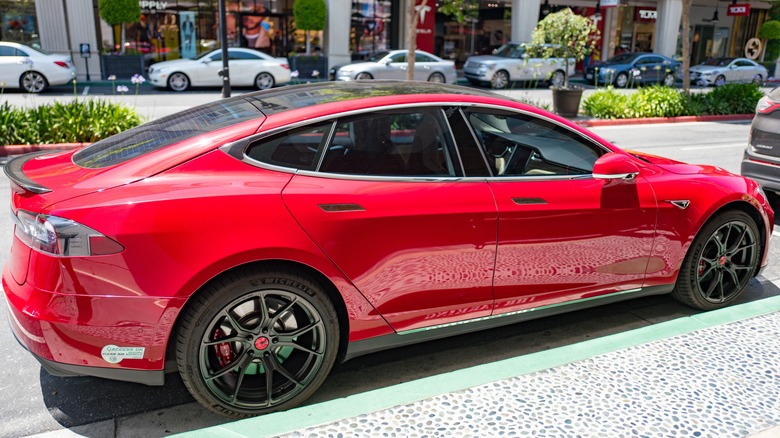10 Things You Should Know Before Buying A Used Tesla Model 3
It's not every day you come across a car that rewrites the rulebook on what driving feels like, yet the Tesla Model 3 did just that when it arrived for the 2017 model year with a minimalist interior, swift acceleration, and that infamous single-pedal driving.
The Model 3 has since become Tesla's best-selling sedan, appealing to those seeking sustainable driving without compromising on performance or style. However, purchasing a used Model 3 requires careful consideration. Not all Tesla Model 3s come with the same features or warranties, some might include Autopilot, while others have Full Self-Driving. Early models sometimes had minor build-quality issues, including panel gaps and paint issues and the car's battery life depended a lot on how it was treated by the previous owner. Skipping these details could lead to costly headaches down the road.
That's why it's important to do the right research. This guide highlights ten crucial things to look for, including how to check battery health, what to watch out for in service records, and how to navigate Tesla's sometimes confusing software updates. Armed with this knowledge, it'll be easier to spot a great deal and dodge unexpected costs. If the idea of cheaper, all-electric driving sounds appealing but there's still a need for a smart purchase, these tips will help.
Inspect the battery condition
Not all Tesla batteries are created equal, and the Model 3's pack has undergone several changes since its 2017 debut. Early Model 3 sedans used 2170 lithium-ion cells in different capacities. The Standard Range (SR) and Standard Range Plus (SR+) featured 50 kWh packs, offering modest ranges of around 250 miles, while Long Range trims hover closer to 82 kWh and extended range capabilities, typically over 300 miles.
Today, the Model 3 variants include Rear-Wheel Drive (RWD), Long Range AWD, and Performance AWD models, each with specific battery technologies and range capabilities. More recent Standard Range models in some markets even use lithium iron phosphate (LFP) chemistry, which behaves differently in terms of charging and long-term degradation. Understanding which pack a used Model 3 has is the first step in gauging real-world range and overall battery health.
Ask for any records showing how the battery was treated. Frequent Supercharging and consistent 100% charges can speed up wear, especially in older 2170 packs. Tesla's recommended practices, like charging to about 80% or 90% for daily use, are there for a reason. Comparing the current maximum range displayed on the car's screen to the original factory rating reveals if the capacity loss is within normal limits.
When in doubt, consider a Tesla service center inspection. A Model 3's battery pack is its most expensive component, so confirming the battery condition can spare you costly repairs and ensure the electric driving experience stays as efficient as Tesla intended.
Verify the remaining warranty and transferability
For a used Tesla Model 3, one of the biggest financial shields is its warranty coverage. Tesla's New Vehicle Limited Warranty covers most components for four years or 50,000 miles. Meanwhile, the battery and drive unit typically get eight years of coverage, ranging from 100,000 miles for Standard Range (or Standard Range Plus) versions up to 120,000 miles for Long Range and Performance models. Some used Model 3s sold directly by Tesla might include extended warranty terms, which can be a big plus. Private sellers, on the other hand, might not realize how close their coverage is to expiring — or that transferring it isn't always automatic.
Before making an offer, ask for official paperwork detailing how much warranty remains. Verify whether the battery and drive unit warranties are still valid since these are the priciest parts to fix if something goes wrong. Running the Vehicle Identification Number (VIN) through Tesla's support site can clarify the warranty's status. Note that any unauthorized modifications — such as aftermarket suspension components or unofficial software tweaks — could void the warranty, shifting repair costs onto you.
Some owners also choose to maintain service records meticulously, which can help smooth out any claims if issues pop up. Ultimately, the goal is to sidestep nasty surprises such as a cracked screen here or a drive unit hiccup there. Warranties were designed to handle those worries, so confirm that the coverage is still active.
Confirm the inclusion of Autopilot and Full Self-Driving features
A used Tesla Model 3 can feel less futuristic if it's missing its most anticipated features — Autopilot or Full Self-Driving (FSD). Since adding FSD later can cost $8,000 or more, so confirming whether it's already included can save a serious chunk of money.
Early Standard Range trims, for instance, might not include Autopilot or Full Self-Driving (FSD) capabilities by default, even if the hardware is installed. Basic Autopilot, now standard on all new Tesla vehicles, includes Traffic-Aware Cruise Control and Autosteer, while Enhanced Autopilot (EAP) adds Navigate on Autopilot, Auto Lane Change, Summon, and Autopark. Full Self-Driving promises additional features, such as Traffic Light and Stop Sign Control, and Autosteer on city streets, but it requires Tesla's HW3.0 computer for full functionality.
Before making any commitments, tap the Autopilot section in the vehicle's software menu. These capabilities also differ across Model 3 variants. The Rear-Wheel Drive (RWD) base model, for example, might lack some of the premium features seen in the Performance AWD variant. If the seller claims it includes FSD, request documentation that spells out its status.
While some owners pay thousands of dollars for FSD, Tesla's policies have shifted over time, leaving certain secondhand buyers surprised when a feature they expected didn't transfer. It's easy to get carried away by promises of full autonomy. Keep in mind that Tesla may have added or removed certain features during software updates, and hardware changes could affect FSD eligibility.
Review the vehicle's service history
Electric cars may dodge oil changes and other gas-engine headaches, but they still need occasional care to stay roadworthy. The Tesla Model 3 is no exception, even if its service intervals are less frequent than traditional vehicles. Checking a car's repair and maintenance history can reveal whether it's been properly looked after or if it's been left to fend for itself. Some owners might assume electric cars need zero upkeep and skip these basics altogether, which can lead to expensive surprises later on. That's why a thorough look at the car's service history is crucial.
Ask the seller for access to any official Tesla digital service records. These can show whether key procedures — such as software updates, battery coolant checks, or recall fixes — were actually performed. If the Model 3 was ever in an accident or had major repairs, verify that documentation is okay. Receipts and insurance claims can offer proof that the work was done correctly, rather than just patched up.
It's also smart to see if the car is subject to any Tesla recall notices or open campaigns that haven't been addressed. Even something as simple as a missed firmware update can affect performance or introduce glitches over time. The goal here is to avoid hidden problems that could lead to surprising repair bills later. If the service records look thorough and consistent, it's a sign the car has been treated well. However, if those records are missing or incomplete, it's wise to proceed with caution.
Understand software updates and versions
Few things define Tesla's technology edge like its over-the-air updates, and the Model 3 is a prime example. These software packages can patch bugs, refine camera performance, and sometimes even bump horsepower or add new entertainment options — all without a trip to the service center. However, lagging behind on important updates could mean missing out on fresh features or carrying forward glitches that Tesla has already fixed.
When considering a used Model 3, it's wise to see which software version it's running. Tapping the Software tab on the touchscreen reveals if the car has skipped key releases. Since Tesla staggers its rollouts, some owners get new versions weeks before others. If the previous owner didn't consistently install updates, the vehicle might lack useful functions like Sentry Mode improvements or Autopilot refinements. Plus, older Model 3s with first-generation Autopilot hardware (HW2.5) may not support everything found in newer builds (HW3.0).
Rapid remote fixes have also allowed Tesla to tackle certain recalls and safety issues more quickly than traditional automakers. Still, it's important to remember that (older) hardware constraints can limit the Model 3's ability to receive certain upgrades. Confirming which updates the car is eligible for helps ensure it's keeping pace with Tesla's evolving ecosystem.
Inspect for free Supercharging eligibility
Free Supercharging once stood out as a major Tesla perk, but the Model 3 didn't always enjoy the same unlimited privileges that some early Model S and Model X owners received. In certain promotions from 2017 through 2019, Tesla briefly offered referral-based free Supercharging on the Model 3, yet these benefits often hinged on the original owner. As a result, not every used Model 3 still carries the perk, and even if it was included at purchase, it may not transfer automatically.
To confirm whether a specific Model 3 still qualifies, check its Vehicle Identification Number (VIN) through Tesla's support website or contact Tesla customer service directly. Sometimes, sellers advertise free Supercharging without realizing it's tied to a personal account. If that's part of what makes the deal appealing, it's worth verifying in the car's online account settings or by asking Tesla to confirm who currently holds the free-charging right.
For road warriors, unlimited access to the Supercharger network can save hundreds or even thousands of dollars over time. Meanwhile, cars without free Supercharging pay per session or per kilowatt-hour, depending on local rates — still cheaper than gasoline, but not as sweet as free. Ultimately, nailing down the Model 3's charging status prevents unpleasant surprises and helps gauge the true cost of ownership, especially for those planning frequent highway trips. If the perk genuinely transfers, consider it a big bonus. If not, calculate those extra costs before committing.
Thoroughly inspect the car's condition
Although the Model 3 might impress with its minimalist interior and considerably decent acceleration, not every one of them looks or feels perfect off the assembly line, and wear and tear from a previous owner can compound minor flaws. Over time, issues like panel gaps or misaligned body parts can crop up, especially in earlier production years. A glance may not reveal much, so walk around the car and inspect every seam. Suspension-related problems can also emerge if the vehicle has been driven hard or subjected to potholes, so pay attention to any uneven wheel alignment or strange sounds during a test drive.
Another key area to check is the heating and cooling system, as Tesla has faced recalls related to faulty heat pumps. Turn on the climate controls at different temperatures to ensure everything warms up or cools down as it should. Then there's the touchscreen — arguably the command center of the entire car. Though the Model 3 wasn't part of the voluntary recall affecting Model S and X displays, it's still a single point of failure if it starts glitching or freezing. Test every function, from navigation to music streaming, to confirm it's all working smoothly.
Lastly, don't overlook the interior. Worn seats, scuffed plastics, or neglected carpets can hint that the previous owner wasn't big on maintenance. If any red flags appear, consider a professional inspection with someone who knows EVs inside out. A thorough checkup now can prevent costly surprises.
Ensure all charging equipment is included
Unlike a gas car, an electric vehicle lives or dies by its charging setup. The Model 3 is no exception. While Tesla used to include the Mobile Connector kit by default, policies have changed over the years, so not every used car will have the full array of cables and adapters. Missing just one crucial piece — such as the NEMA 14-50 adapter or the J1772 connector for non-Tesla stations — can quickly lead to both inconvenience and unexpected costs. Tracking down these components afterward isn't always cheap, and availability can sometimes be hit-or-miss.
Before signing anything, request a detailed list of what comes with the car, or better yet, inspect the actual items in person. Look for the Mobile Connector itself, the standard household plug adapter, and any additional tips for Level 2 charging. Tesla's official charging guide is a great reference for what a brand-new Model 3 typically includes, making it easy to see if something important is missing. Remember, a seller might not realize how costly these accessories are to replace, so it's wise to clarify upfront.
Home charging is often the most cost-effective way to power up a Model 3, so having the right setup from day one saves money and headaches. Even if Superchargers are readily available in your area, a well-stocked at-home setup saves time and potentially money in the long run. Any missing piece can leave you scrambling for a workaround.
Research model year differences
Tesla rolls out updates to the Model 3 whenever they're ready, which means two Teslas from the same year could have dramatically different hardware and features. A 2021 Model 3 built early in the year, for example, might lack some of the tweaks found on a late-2021 version, such as revised headlights or double-pane windows for noise reduction. Tesla also experimented with different trunk release mechanisms and redesigned the center console around 2020 and 2021, so a car produced just a few months apart might look noticeably different inside.
Currently, the Model 3 is available in three variants: the rear-wheel-drive base model, the Long Range dual-motor AWD, and the Performance dual-motor AWD. Each variant offers distinct features, ranging from improved range in the Long Range model (up to 358 miles) to exhilarating acceleration in the Performance trim (0-60 mph in just 3.1 seconds). These differences highlight the importance of confirming a car's specific build date and features to ensure they align with your expectations.
Battery chemistry and range are other key variables. Some Standard Range Plus models shipped with lithium iron phosphate (LFP) packs, allowing comfortable daily charges to 100%. Others are stuck with the more familiar NMC (nickel-manganese-cobalt) batteries, which Tesla recommends charging to around 80 to 90% for routine use.
To avoid surprises, verify the vehicle's build date using Tesla's official resources. Checking owner forums and EV websites can also provide insights into subtle updates, ensuring you make an informed choice.
Consider the total cost of ownership
Finding a bargain on a used Model 3 is exciting, but remember that running costs don't end with the purchase price. Maintenance can be simpler than a gas car — there's no engine oil to replace, and regenerative braking tends to extend brake life. However, specialized EV components like the high-voltage battery, drive unit, or Autopilot sensors can drive up repair bills if something fails. In fact, some estimates show Tesla repair costs can be over 27% higher than the industry average, largely due to the unique parts and training required.
Insurance is another key consideration. Teslas often cost more to insure than comparable gas vehicles, partly because advanced technology like cameras and radar can be pricey to replace. Insurance premiums also vary significantly between variants. The Performance AWD model, equipped with high-end features and increased power, typically incurs higher insurance costs compared to the Rear-Wheel Drive (RWD) and Long Range AWD versions. Rates vary by region and personal driving history, so getting multiple quotes offers a clearer picture of monthly and annual premiums.
Electricity costs can be a wild card, too. Home charging rates differ significantly from one utility to another, and frequent highway travelers might rely heavily on Superchargers, which charge by the kilowatt-hour or per minute in many regions. The costs can add up for high-mileage drivers. By tallying insurance, maintenance, and charging expenses ahead of time, buyers can make sure the Model 3 fits comfortably within their budget.
